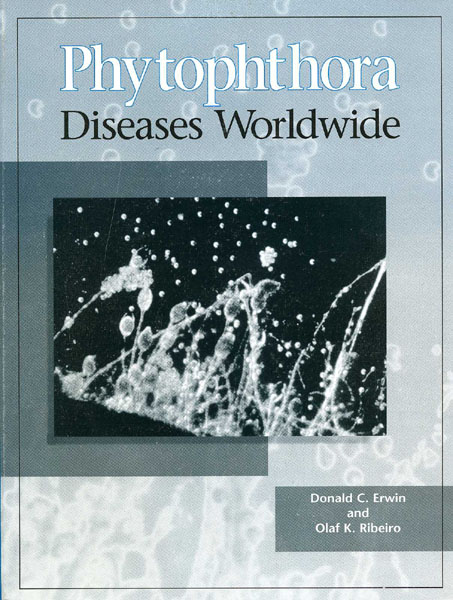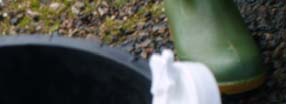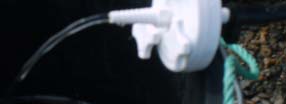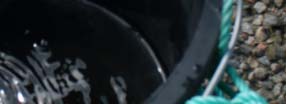Microsoft powerpoint - o1brasier biodiversity icpp turin

Clive Brasier
Forest Research Agency
Farnham UK
Many new Phytophthora species are being
discovered.
This prompted me to take a look at the
theoretical question:
How many Phytophthoras species are there?
What might the answer mean for Phytophthora
taxonomy and phylogeny? . and for the plant
health risk to forests and natural ecosystems?
(cf. P. alni, P. ramorum etc)
Going to explore these issues. It seems best to
begin with a brief history of Phytophthora
species over time.
Phytophthora species over time
1876 Anton De Bary
1 species
up to 1920 generic confusion
1931 C M Tucker ca 20 species
1963 G M Waterhouse ca 41 species
1976 Newhook, Waterhouse, Stamps ca 50 species
1996 Erwin, Ribeiro
ca 54 species

Phytophthora species over time
1996 Erwin & Ribeiro ca 54 species
Phytophthora species described Pre 2000
In Erwin & Ribeiro 1996
P. arecae
P. erythroseptica
P. japonica
P. phaseoli
P. boehmeriae
P. fragariae frag.
P. katsurae
P. porri
P. botryosa
P. fragariae rubi
P. lateralis
P. primulae
P. cactorum
P. gonapodyides
P. macrochlamy.
P. pseudotsugae
P. cajani
P. heveae
P. meadii
P. quercina 1999
P. cambivora
P. hibernalis
P. medicaginis
P. quininea
P. capsici
P. humicola
P. megakarya
P. richardiae
P. cinnamomi
P. idaei
P. megasperma
P. sinensis
P. citricola
P. ilicis
P. melonis
P. sojae
P. citrophthora
P. infestans
P. mexicana
P. syringae
P. clandestina
P. inflata
P. mirabilis
P. tentaculata
P. colocasiae
P. insolita
P. multivesiculata
P. trifolii
P. cryptogea
P. iranica
P. nicotianae
P. vignae
P. drechsleri
P. italica
P. palmivora
Phytophthora species over time
1876 Anton De Bary
1 species
up to 1920 generic confusion
1931 C M Tucker ca 20 species
1963 G M Waterhouse ca 41 species
1976 Newhook, Waterhouse, Stamps ca 50 species
1996 Erwin, Ribeiro
ca 54 species
1999 + P. quercina
ca 55 species
Round off (part described taxa etc) 60 species pre 2000
How many Phytophthoras?
Take as the baseline ca 60 species known pre 2000
Hawksworth (2001) estimated only 10% of fungi were
known to science.
Crous & Groenwald (2005) estimated only 7% known
Take 10% as the estimate of unknowns
Then there may be 600 Phytophthora species in
total, of which only 60 species were accounted for
by 2000
Leaving 540 still unknown in 1999!
How many Phytophthoras?
Instead of 600, take a much more conservative
estimate: 200-600 extant Phytophthora species
Then there may have been anything from 140 - 540
unknown species in ca 2000
An average of 340 ± 200 species still unknown
How many of these 140 - 540 unknown
species might damage forests or natural
ecosystems if they become invasives?
Phytophthora species described Pre 2000
P. fragariae frag.
P. fragariae rubi
Phytophthora species described Pre 2000
Damaging to nursery trees, forests and natural ecosystems
P. fragariae frag.
P. fragariae rubi
11 / 55 = 20%
How many Phytophthoras?
So information prior to 2000 suggests 20%
of Phytophthoras were damaging to forests
or natural ecosystems
Take as a more conservative estimate
10%.
Then on this basis, in 2000 there may still
have been between 14 - 54 ie average 34 ± 20
unknown Phytophthora species potentially
damaging to forests or natural ecosystems
And since 2000? .
Phytophthora species
P. arecae
P. japonica
P. boehmeriae
P. katsurae
P. botryosa
P. lateralis
P. cactorum
P. macrochlamydospora
P. cajani
P. meadii
P. cambivora
P. medicaginis
P. capsici
P. megakarya
P. cinnamomi
P. megasperma
P. citricola
P. melonis
P. citrophthora
P. mexicana
P. clandestina
P. mirabilis
P. colocasiae
P. multivesiculata
P. cryptogea
P. nicotianae
P. drechsleri
P. palmivora
P. erythroseptica
P. phaseoli
P. fragariae var frag.
P. porri
P. fragariae var rubi
P. primulae
P. gonapodyides
P. pseudotsugae
P. heveae
P. quercina
P. hibernalis
P. quininea
P. humicola
P. richardiae
P. idaei
P. sinensis
P. ilicis
P. sojae
P. infestans
P. syringae
P. inflata
P. tentaculata
P. insolita
P. trifolii
P. iranica
P. vignae
55
Phytophthora species Post 2000
Phytophthora species
Described or under construction
P. arecae
P. japonica
P. alni (x3)
P. alticola
P. boehmeriae
P. katsurae
P. andina
P. frigida
P. botryosa
P. lateralis
P. asparagi
P. austrocedrae
P. cactorum
P. macrochlamydospora
P. bisheria
P. lagoariana
P. cajani
P. meadii
P. brassicae
P. cuyabensis
P. cambivora
P. medicaginis
P. captiosa
P. cact x hed
P. capsici
P. megakarya
P. europaea
P. foliorum
P. cinnamomi
P. megasperma
P. fallax
P. sulawesiensis
P. citricola
P. melonis
P. gallica
P. siskiyouensis
P. citrophthora
P. mexicana
P. glovera
P. uliginosa
P. clandestina
P. mirabilis
P. hedraiandra
P. colocasiae
P. multivesiculata
P. inundata
P. taxon salixsoil
P. cryptogea
P. nicotianae
P. ipomoeae
P. taxon pgchlamydo
P. drechsleri
P. palmivora
P. kelmania
P. taxon riversoil
P. erythroseptica
P. phaseoli
P. kernoviae
P. taxon oaksoil
P. fragariae var frag.
P. porri
P. nemorosa
P. parvasperma
P. fragariae var rubi
P. primulae
P. niederhauserii
P .hungarica
P. gonapodyides
P. pseudotsugae
P. pistaciae
P. sylvatica
P. heveae
P. quercina
P. polonica
P. parsiana
P. hibernalis
P. quininea
P. pseudosyringae
P. quercetorum
P. humicola
P. richardiae
P. psychrophila
P. taxon meadii-like
P. idaei
P. sinensis
P. ramorum
P. taxon Acer
P. ilicis
P. sojae
P. sansomea
P. taxon Agathis
P. infestans
P. syringae
P. taxon. Banksia
P. taxon orphan
P. inflata
P. tentaculata
P. taxon. Chicory
P. insolita
P. trifolii
P. cact x nic
P. iranica
P. vignae
P. tropicalis
55
50+
Phytophthora species Post 2000
Species described or under construction
P. alni (x 3)
P. taxon oaksoil
P. cact x hedr
P. taxon Acer
P. cact x nic
P. taxon Agathis
P. taxon orphan
51 – (54)
Phytophthora species / taxa Post 2000
Associated with research on nursery trees, forests and
natural ecosystems
P. alni (x 3)
P. kernoviae
P. frigida
P. taxon salixsoil
P. andina
P. nemorosa
P. austrocedrae
P. tax. pgchlamydo
P. asparagi
P. niederhauserii
P. lagoariana
P. taxon riversoil
P. bisheria
P. pistaciae
P. cuyabensis
P. taxon oaksoil
P. brassicae
P. polonica
P. cact x hedr
P. parvasperma
P. captiosa
P. pseudosyringae P. foliorum
P .hungarica
P. europaea
P. psychrophila
P. sulawesiensis P. sylvatica
P. fallax
P. ramorum
P. siskiyouensis
P. parsiana
P. gallica
P. sansomea
P. uliginosa
P. quercetorum
P. glovera
P. taxon Banksia
P. pinifolia
P. tax. meadii-like
P. hedraiandra
P. taxon. chicory
P. taxon Acer
P. inundata
P. cact x nic
P. taxon Agathis
P. ipomoeae
P. tropicalis
P. taxon orphan
P. kelmania
P. alticola
31+ /51 = 60 %
Estimate for the 55 pre- 2000 species was only 20% .
Phylotypes or ‘virtual taxa'
Molecular technology, especially PCR, has provided
opportunity to probe the environment for known or
unknown taxa based solely on DNA sequence
profiles.
Especially used in bacteriology where soil profiles
revealing remarkable numbers of prokaryote
organisms.
Since the product is a DNA sequence to fit to a
phylogenetic tree and no culture is available the
resulting ‘taxa' are commonly referred to as
phylotypes.
For Phytophthora, I have personally tended to think
of them as ‘virtual taxa' to underline the lack of hard
information.
Virtual taxa or phylotypes
Arcate, Karp & Nelson (2006) recently applied
these methods to search for Oomycetes in
tomato and other rhizosphere soils in NY State.
They found -
Many Pythiums! (and a couple of
Phytopthoras)
Greater diversity than by direct baiting
methods
They were able to the sample the dormant
oospore flora as well as active propagules.
Virtual taxa or phylotypes
At least two other research groups have
begun to apply these methods to screen
for Phytophthoras in forests and natural
ecosystems, so far mainly in water
environments (streams):
• Everett Hansen's group at Corvallis
• David Cooke's group at SCRI Dundee
Phytophthora species Post 2000
Phytophthora species
Described or under construction
Phylotypes or virtual taxa
P. arecae P.
japonica P. alni (x3)
P. alticola
P. boehmeriae P.
P. andina
P. frigida
SW Oregon streams
Hansen / Reeser / Sutton
P. botryosa
P. lateralis
P. asparagi
P. austrocedrae
Combined SSCP of ITS, Cox
P. cactorum
P. macrochlamydospora
P. bisheria
P. lagoariana
30 species
P. cajani P.
meadii P. brassicae
P. cuyabensis
10 unknown / new taxa ?
P. cambivora
P. medicaginis
P. captiosa
P. cact x hed
P. capsici P.
P. europaea
P. foliorum
Central Oregon stream (Oak Creek)
P. cinnamomi
P. megasperma
P. fallax
P. sulawesiensis
Remigi / sutton / Reeser / Hansen
P. citricola
P. melonis
P. gallica
Combined SSCP of ITS, Cox
P. siskiyouensis
11 specie s
P. citrophthora
P. mexicana
P. glovera
P. uliginosa
5 unknown / new taxa ?
P. clandestina
P. mirabilis
P. hedraiandra
P. pinifolia
P. colocasiae
P. multivesiculata
P. inundata
West Australian bush
P. cryptogea
P. nicotianae
P. ipomoeae
P. taxon salixsoil
P. drechsleri P.
palmivora P. kelmania
P. taxon pgchlamydo
P. erythroseptica
P. phaseoli
P. kernoviae
P. taxon riversoil
9 unknown / new taxa ?
P. fragariae var frag.
P. porri
P. nemorosa
P. taxon oaksoil
P. fragariae var rubi
P. primulae
P. niederhauserii
P. parvasperma
West Scotland streams
P. gonapodyides
P. pseudotsugae
P. pistaciae
P .hungarica
Scibetta / Cooke / Cacciola
P. heveae
P. quercina
P. polonica
P. sylvatica
17 species
P. hibernalis
P. quininea
P. pseudosyringae
P. carica
3 unknown / new taxa ?
P. humicola
P. richardiae
P. psychrophila
P. quercetorum
P. idaei P.
P. ramorum
P. taxon meadii-like
P. ilicis
P. sojae
P. sansomea
P. taxon Acer
Scibetta / Cooke
P. infestans
P. syringae
P. taxon. Banksia
P. taxon Agathis
P. inflata
P. tentaculata
P. taxon. Chicory
P. taxon orphan
10 species
P. insolita
P. trifolii
P. cact x nic
4 unknown / new taxa ?
P. iranica
P. vignae
P. tropicalis
55
Phytophthora species post 2000
Phylotypes or virtual taxa
West Scotland streams
Scibetta / Cooke / Cacciola
SW Oregon streams
Hansen / Reeser / Sutton
17 species
Combined SSCP of ITS, Cox
3 unknown / new taxa ?
30 species
10 unknown / new taxa ?
Ecuador streams
Scibetta / Cooke
Central Oregon stream (Oak Creek)
10 Phy species (+ 3 Per spp)
Remigi / Sutton / Reeser / Hansen
4 unknown / new taxa ?
Combined SSCP of ITS, Cox
11 species
West Australian bush
5 unknown / new taxa ?
ITS sequence
9 unknown / new taxa ?
Electropherogram for ITS1 products generated by
Slide courtesy Hansen et al
Phytophthora diversity in streams and soil -
ITS1 and COX spacer peaks for some unknown isolates
Slide courtesy Hansen et al
South west Oregon streams
Hansen / Reeser / Sutton
Combined SSCP of ITS, Cox
30 Phytophthora species
10 unknown / new taxa ?
Central Oregon stream (Oak Creek)
Remigi / Sutton / Reeser / Hansen
Combined SSCP of ITS, Cox
11 Phytophthora species
5 unknown / new taxa ?






Monitoring Phytophthora using
molecular methods
Silvia Scibetta, David Cooke & Santina Cacciola
* Inverpolly
* BeinnEighe
Loch Lomond
1st round product 490bp
Clyde Valley
Nested product 260bp
No cross reaction with Pythium
Nature reserves sampled
(water and soil)
• DNA extraction
• PCR
• Cloning
• Sequencing
10 litre samples of standing or flowing water filtered
Phytophthora phylotypes found in
2006 Scottish Survey
P. t hedraiandra-like
P. hedraiandra
P. taxon Oaksoil
P. taxon Pgchlamydo
P. hedraiandra-
P. hedraiandra
P. taxon Oaksoil
Pgchlamydo
P.gonapodyides*
Number of species
P.alni subsp.
P.gonapodyides
P.alni subsp.
Fewer samples from soil but
up to 5 species detected in a
P.euro P.e
single water sample
P. taxon Salixsoil
P. taxon Salixsoil
P. taxon Raspberry
17 different Phytophthora sp. in water
samples cf. only 5 in soil samples
West Scotland streams
Scibetta / Cooke / Cacciola
17 Phytophthora species
3 unknown / new taxa ?
Ecuador streams 2 - 3000 m. asl.
Scibetta / Cooke
Combined SSCP of ITS, Cox
10 Phytophthora species
(+ 3 Peronospora spp)
3 unknown / new taxa ?
West Australian Bush -
unidentified isolates
Stukely/ Burgess / Hardy
Screening of the VHS culture collection - ITS
sequence data and blast search
7-9 unknown / new taxa ?
NB. Not phylotaxa, because cultures are
available
Phytophthora species Post 2000
Phytophthora species
Described or under construction
Virtual taxa or phylotypes
P. arecae P.
japonica P. alni (x3)
P. alticola
P. boehmeriae P.
P. andina
P. frigida
SW Oregon streams
Hansen / Reeser / Sutton
P. botryosa
P. lateralis
P. asparagi
P. austrocedrae
Combined SSCP of ITS, Cox
P. cactorum
P. macrochlamydospora
P. bisheria
P. lagoariana
30 species
P. cajani P.
meadii P. brassicae
P. cuyabensis
10 unknown / new taxa ?
P. cambivora
P. medicaginis
P. captiosa
P. cact x hed
P. capsici P.
P. europaea
P. foliorum
Central Oregon stream (Oak Creek)
P. cinnamomi
P. megasperma
P. fallax
P. sulawesiensis
Remigi / sutton / Reeser / Hansen
P. citricola
P. melonis
P. gallica
P. siskiyouensis
Combined SSCP of ITS, Cox
P. citrophthora
P. mexicana
P. glovera
P. uliginosa
11 specie s
P. clandestina
P. mirabilis
P. hedraiandra
P. pinifolia
5 unknown / new taxa ?
P. colocasiae P.
P. inundata
P. cryptogea
P. nicotianae
P. ipomoeae
P. taxon salixsoil
West Australian bush
P. drechsleri P.
palmivora P. kelmania
P. taxon pgchlamydo
P. erythroseptica
P. phaseoli
P. kernoviae
P. taxon riversoil
P. fragariae var frag.
P. porri
P. nemorosa
P. taxon oaksoil
9 unknown / new taxa ?
P. fragariae var rubi
P. primulae
P. niederhauserii
P. parvasperma
P. gonapodyides
P. pseudotsugae
P. pistaciae
P .hungarica
West Scotland streams
P. heveae P.
quercina P. polonica
P. sylvatica
Scibetta / Cooke / Cacciola
P. hibernalis
P. quininea
P. pseudosyringae
P. carica
P. humicola
P. richardiae
P. psychrophila
P. quercetorum
17 species
P. idaei P.
P. ramorum
P. taxon meadii-like
3 unknown / new taxa ?
P. ilicis
P. sojae
P. sansomea
P. taxon Acer
P. infestans
P. syringae
P. taxon. Banksia
P. taxon Agathis
P. inflata
P. tentaculata
P. taxon. Chicory
P. taxon orphan
Scibetta / Cooke
P. insolita P.
P. cact x nic
10 species
P. iranica
P. vignae
P. tropicalis
51+
55
4 unknown / new taxa ?
Described Phytophthora species over time
Described Phytophthora species over time
Period of evolutionary and genomic exploration
Period of discovery
morphology pathology
and ‘certainty'
Why such an increase in species since
2000?
The emergence of more holistic, population-
based species concepts since the 1980s
The rapid application of molecular tools for
defining evolutionary units in fung
Increasing international trade in rooted plants
Increased environmental screening for
Phytophthora species – sample surveys
Growing number of described Phytophthora
species: significance for Phylogeny?
ca 50 Phytophthora
species
Cooke et al 2000
Oomycete ITS tree
Hansen group
Water filtering method in use (Yunnan)
Growing number of described Phytophthora
species: significance for Phylogeny?
Since 2000 seeing
marked increase in
species in Clades 9
and 10 (only about
3 species known in
2000)
Cooke et al 2000
Oomycete ITS tree
Blair et al 2006 seven locus consensus tree
Today already ca 10
‘new' species in these
clades….
Cooke et al 2000 ITS tree Clades 1-8 only ca 47 species
In Clades 1-8:
Since 2000 - a
rapid increase in
species in
Clades1-8
e.g. 3 new
species
associated with
the previously
remote P.
lateralis subclade
in Clade 8
Cooke et al 2000 ITS tree Clades 1-8 ca 47 species
Blair et al 2008 seven locus consensus tree
P. lateralis now
joined by
P.hibernalis,
P.ramorum,
P.foliorum
Since 2000 a
dramatic increase
in Clade 6 species
5 species in 2000
Cooke et al 2000 ITS tree Clades 1-8 ca 47 species
15 taxa in Clade 6 by 2004:
Strill growing: would
now need to add P.
hungarica sp.nov; P.
taxon orphan: P.
pinifolia .
Brasier et al 2004 ITS tree Clade 6
100 P.sp. 10
Clade 6 taxa
67 6197 P.sp. 3
ITS sequence tree
courtesy Burgess,
100 Phytophthora arecae
100 P.sp. 1
100 P.sp. 9
10 changes
South west Oregon streams
Hansen / Reeser / Sutton
Combined SSCP of ITS, Cox
30 Phytophthora species
10 unknown / new taxa ?
Majority probably in Clade 6
So how many species in Clade 6?
Take the 2007 data:
ca 17 of the 105 known Phytophthora species are in Clade 6
= 16% - ‘biggest' Clade of all?
Taking the estimate of 200 - 600 total Phytophthora species
This gives an estimate of 32-96 species in Clade 6
(Clade 6 by 2004)
Brasier et al 2004 ITS tree Clade 6
‘Enlarge' hypothetically to ca 32 spp:
If many of these 32 (- 96)
‘new' species are also
aquatic, sterile or inbreeding,
high temperature species like
Pg, P t pgchlamydo etc –
– we may even have to
rethink our species concept
for this subclade
So we now have new and
rapidly expanding
molecular phylogenetic
trees :
But what do these trees
mean in terms of how we
understand
Phytophthoras?
Obviously the trees are a major step forward
from the Waterhouse 1963 morphological
Groups 1-6
- The former were identification aids and
were necessarily artificial constructs -
- Whereas our molecular trees are closer to
‘natural relationships'
Noneless I suggest we treat them with
a degree of caution:
1. Much data is missing because of extinctions!
2. Much data is
missing because we
still have to add the
100 – 500 extant
species!
3. Much evidence of past reticulation events is
missing …
…the footprints of
hybridisation and
genetic introgression
will have been lost
over time …
What is important is not so much that we can
show that species X and species Y are related…
eg that P. ramorum and P. lateralis are related
In Darwinian terms,
what is more important
is to understand the
processes and events
that gave rise to their
divergence…
The Darwinian
meaning is all in the
nodes …
Why did ancestral
species W give rise
to three species X,
Y and Z.?
ancestral
species A give
rise to two
clades 1 and 2?
and so on.
Concluding comments .
This dip into Phytophthora numerical
biodiversity and phylogenetic uncertainties
has put me in mind of just how little we
know about the origins of the genus.
Indeed, it seems reasonable to suggest that
the construction of a phylogenetic tree is
simply the point at which the real
evolutionary challenges begin.
So, given that there are probably 200-600
species of Phytophthora out there -
- I see two key challenges for the future:
1. Understanding why there are so many
Phytophthoras. ie. What environmental
processes and events (geographic, climatic,
biotic) drove their evolution? Why did eg P.
ramorum diverge from P. lateralis?
- the job of the evolutionary biologist
2. Understanding at the genetic level how eg P.
ramorum behaves so differently from P. lateralis?
- the job of the genomicist
Fortunately, these how and why
challenges are not mutually exclusive,
and answers obtained for one will
enormously benefit the understanding in
the other.
I suggest, therefore, that we are in for an
exciting time over the next decade!
Thank you
A written version of this talk will be published shortly:
Brasier C. M (2008). Phytophthora biodiversity: How many Phytophthora species are there? InProceedings of the 4th IUFRO Workshop on Phytophthoras in Forests and Natural Ecosystems(E. Goheen ed). in press USDA Forest Service.
Source: http://www.phytophthoradb.org/pdf/O1Brasier.pdf
Protocolo para el manejo perioperatorio de la medicación crónica Cristina Roure Nuez, David López Sisamón, Margarita Prats Riera Grupo de trabajo sobre el manejo perioperatorio de la medicación habitual de la Societat Catalana de Farmàcia Clínica: Coordinadores: Cristina Roure (SCIAS-Hospital de Barcelona) David López (Hospital de la Santa Creu i Sant Pau)
Autologous fat grafts placed around temporomandibular joint total joint prostheses to prevent heterotopic bone formation Larry M. Wolford, DMD, Carlos A. Morales-Ryan, DDS, MSD, Patricia Garcia Morales, DDS, MS, and Daniel Serra Cassano, DDS the treatment of ankylosis This study evaluated 1) the efficacy of packing autologous fat grafts of the temporomandibular around temporomandibular joint (TMJ) total joint prosthetic reconstruc-









